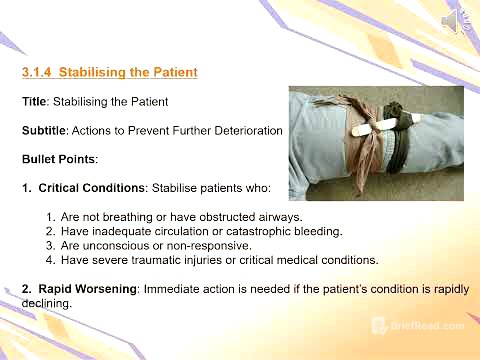TLDR;
This YouTube video, titled "Master Your Mind: Unlock Peak Performance for Your Best Life," serves as an introduction to a transformative guide focused on harnessing the power of mindset to achieve extraordinary success. It emphasises that mindset shapes actions, emotions, decisions, and ultimately, success. The video outlines key concepts such as developing a growth mindset, mastering self-discipline and resilience, harnessing visualisation and positive thinking, and maintaining focus on goals. It promises practical tools and strategies to overcome limitations and achieve peak performance in all areas of life.
- The mind's unseen influence shapes experiences and outcomes.
- The mind-body connection highlights the impact of mental states on physical health.
- Neuroplasticity empowers individuals to rewire their brains for success.
- Techniques like mindfulness, affirmations, visualisation, and gratitude can harness the mind's power.
Introduction: Welcome to Peak Performance [0:00]
The video introduces "Master Your Mind: Unlock Peak Performance for Your Best Life," a guide designed to help viewers tap into their mind's power and achieve their true potential. It asserts that mindset is the key differentiator between those who succeed and those who fall short. The book aims to teach viewers how to cultivate the mindset of high performers, providing tools and strategies to overcome limitations, develop motivation, and maintain focus. It promises to transform the approach to life, master self-discipline, harness visualisation, and train the mind for success.
Chapter 1: The Power of the Mind [2:26]
This chapter explores the untapped power of the mind and its connection to thoughts, emotions, and actions. It challenges the notion that success is solely about hard work, talent, or luck, arguing that mindset is the determining factor. The chapter is divided into sections that discuss the mind's unseen influence, the mind-body connection, brain plasticity, and techniques to harness the mind's power. It encourages viewers to take ownership of their minds and consciously unlock their potential.
Chapter 1: The Mind's Unseen Influence [3:31]
This section discusses how constant mental chatter shapes experiences and outcomes, often unconsciously controlling habits, emotions, and physical health. It highlights that becoming aware of how the mind operates allows one to take control. Thoughts influence energy, focus, and the ability to take action, with doubt creating mental blocks and belief opening possibilities. The section reinforces the saying "What you think, you become," explaining that thoughts directly influence emotions and actions. It also introduces neuroplasticity, the brain's ability to reorganise itself by forming new neural connections, allowing individuals to rewire their brains for success.
Chapter 1: The Mind-Body Connection [6:17]
The section explores the intrinsic link between the mind and body, where mental states affect physical responses. Anxiety and stress cause tension and increased heart rate, while calmness promotes relaxation. Mental clarity and positivity release endorphins, creating a feedback loop where positive thoughts lead to a healthier body, and vice versa. Chronic stress elevates cortisol levels, hampering cognitive function and productivity. Achieving peak performance involves caring for both mental and physical health, as a healthy body supports a clear mind, and a clear mind supports a healthier body.
Chapter 1: Brain Plasticity, Your Superpower [7:57]
This section focuses on neuroplasticity, the brain's ability to form new neural pathways at any age, debunking the traditional belief that the brain becomes rigid after a certain age. It emphasises that individuals are not stuck with limiting habits or thought patterns and have the power to retrain their brains. Overcoming negative behaviours or mindsets requires practice and repetition to strengthen neural connections. Challenging the brain in new ways and pushing outside the comfort zone promotes growth and adaptation.
Chapter 1: Techniques to Harness the Power of Your Mind [9:34]
This section introduces practical techniques to harness the mind's power daily. Mindfulness meditation helps gain control over thoughts, creating space between stimulus and reaction. Positive affirmations reprogram the mind by transforming negative self-talk into empowering beliefs. Visualisation improves performance by creating neural patterns that support desired outcomes, increasing confidence and motivation. Gratitude practice shifts focus to positive aspects, releasing dopamine and serotonin to improve mood and outlook.
Chapter 1: The Path Forward [11:42]
The section emphasises the importance of becoming aware of the mind's power and using this knowledge to one's advantage. The mind is a tool that can work for or against you, and the choice is yours. Mastering thoughts, emotions, actions, and habits will lead to unlocking peak performance and living your best life. Shifting the mindset to one designed for success is the next step, empowering individuals to take control and master their minds.
Chapter 2: Shifting Your Mindset [12:50]
This chapter addresses breaking free from negative thought patterns and limiting beliefs. It highlights the power to change one's mindset and transform their life, shifting from self-doubt to self-assurance. The chapter focuses on the mindset shift as the foundation for unlocking peak performance, examining how current mindsets limit success and how to shift towards greatness. This shift is presented as a practical process that can change the approach to challenges and opportunities.
Chapter 2: The Power of a Growth Mindset [14:06]
This section introduces the concept of a growth mindset, developed by psychologist Carol Dweck, which posits that abilities and intelligence are not fixed but can be developed through effort, learning, and persistence. This contrasts with a fixed mindset, which believes abilities are innate and unchangeable. Adopting a growth mindset transforms challenges into opportunities, failures into stepping stones, and effort into the key to mastery. This mindset boosts resilience and opens the door to continuous growth, seeing setbacks as valuable lessons.
Chapter 2: Identifying Limiting Beliefs [16:17]
This section focuses on identifying limiting beliefs, which are deeply ingrained thoughts and assumptions about oneself and the world. These beliefs, often formed early in life, shape the approach to challenges, relationships, and opportunities. Common limiting beliefs include thoughts like "I'm not smart enough" or "I'll never be able to change." The section emphasises that these beliefs are not facts but changeable thoughts. An exercise is provided to uncover limiting beliefs by reflecting on areas of discouragement, identifying associated thoughts, challenging their validity, and finding contrary evidence.
Chapter 2: Reframing Negative Thoughts [18:42]
This section discusses reframing limiting beliefs, which involves changing the interpretation of a situation or belief from negative to positive. For example, not getting a promotion can be reframed from "I'm not good enough" to "I'll use this as an opportunity to learn." Reframing requires practice but is powerful, focusing on lessons, opportunities, and growth. The section encourages pausing during negative self-talk and asking how to reframe the thought in a more empowering way.
Chapter 2: Cultivating Self-Compassion [20:12]
This section emphasises the importance of cultivating self-compassion while shifting one's mindset. It highlights that individuals can be their own harshest critics and need to treat themselves with kindness and understanding. Self-compassion means recognising that you're human and will make mistakes. The section provides steps to practice self-compassion: acknowledge feelings, practice self-kindness, and recognise shared humanity. Practicing self-compassion builds a supportive inner dialogue, helping you bounce back faster and maintain motivation.
Chapter 2: Taking Action and Moving Forward [21:38]
This section stresses that shifting one's mindset involves taking action, which bridges thoughts and results. As you shift from limiting beliefs to growth-oriented thinking, take concrete steps toward your goals. Start by setting small, achievable goals that align with your new mindset. Each step reinforces the belief that you're capable of success, solidifying your growth mindset. The journey to peak performance is a process that requires consistent effort.
Chapter 3: Building Mental Resilience [23:42]
This chapter introduces mental resilience as the ability to persevere through challenges, maintain focus, and stay committed to one's vision despite obstacles. It emphasises that mental resilience is essential for peak performance, as life inevitably presents setbacks and hardships. The chapter explores what mental resilience is, why it's crucial, and how to develop it, providing skills to handle tough challenges with grace and determination.
Chapter 3: Understanding Mental Resilience [25:14]
This section defines mental resilience as the ability to adapt to adversity, overcome obstacles, and keep moving forward. It involves bouncing back from setbacks and maintaining focus on long-term goals, even when short-term results are discouraging. Resilience allows individuals to feel emotions, learn from them, and continue moving forward despite them. In the context of peak performance, mental resilience is critical, enabling individuals to handle pressure, bounce back from defeat, and stay committed to their mission.
Chapter 3: Why Resilience Matters for Peak Performance [27:04]
This section highlights that mental resilience fuels peak performance, enabling individuals to keep going when challenges arise. Resilient individuals break down problems, reframe them, and find creative solutions. They understand that success isn't determined by one setback but by their ability to keep learning and adapting. Resilience also involves staying grounded in the face of success, remaining humble, and focusing on the next challenge.
Chapter 3: The Science of Resilience [29:14]
This section explores the science behind resilience, noting that it's a skill that can be developed and strengthened over time. Resilience is tied to mental and emotional processes that can be actively nurtured. Key elements include emotional regulation, which involves managing emotions during challenging situations, and cognitive flexibility, which is the ability to adapt thinking in response to changing circumstances. Social support also plays a crucial role, with resilient individuals leaning on others for support when needed.
Chapter 3: Building Your Own Resilience [31:36]
This section provides strategies for building mental resilience. These include embracing challenges as opportunities for growth, developing a growth mindset, cultivating emotional awareness, focusing on what you can control, building strong relationships, and practicing self-care. Developing resilience is a step-by-step process that requires changing one's attitude toward challenges and strengthening emotional and social support systems.
Chapter 3: Putting It All Together [34:35]
This section reinforces that building mental resilience is about adapting, learning, and growing with each experience. It emphasises that challenges and setbacks are inevitable, but the key is how you respond. Building resilience develops the ability to bounce back stronger each time. Every step, no matter how small, contributes to a more resilient version of yourself.
Chapter 4: Mastering Focus and Clarity [36:01]
This chapter explores the critical components of peak performance: focus and clarity. It highlights the importance of maintaining clarity and focus even when facing distractions and obstacles. The chapter aims to teach viewers how to sharpen their focus, gain clarity, and stay on course, emphasising that this is a skill that can be developed.
Chapter 4: The Importance of Focus [37:50]
This section examines what happens when focus is lost, noting that constant notifications and competing priorities can lead to feeling overwhelmed and unproductive. Focus, on the other hand, is the ability to direct attention intentionally to one thing at a time, eliminating distractions and giving full mental energy to the task at hand. This singular focus allows people to perform at their highest levels, entering a flow state of deep concentration and immersion.
Chapter 4: Understanding the Science of Focus [39:43]
This section delves into the science of focus, explaining that directing attention to a task activates the prefrontal cortex, responsible for higher-level functions. However, the brain is also wired to seek novelty and stimulation, making it easily distracted. It takes about 25 minutes for the brain to regain focus after an interruption. With practice, the brain can be trained to focus better and longer, and mindfulness is one of the best ways to strengthen this ability.
Chapter 4: Strategies for Sharpening Your Focus [41:30]
This section outlines strategies to improve focus and clarity. These include prioritising tasks, eliminating distractions, setting clear goals, using the Pomodoro technique, practicing mindfulness, and resting and recharging. Prioritising tasks involves focusing on fewer things at once, while eliminating distractions requires creating an environment that minimises interruptions. Setting clear goals provides direction, and the Pomodoro technique aligns with the brain's natural focus cycles.
Chapter 4: Overcoming Mental Roadblocks [45:19]
This section addresses mental roadblocks such as procrastination, self-doubt, and burnout. Overcoming these obstacles involves developing an awareness of them and learning how to manage them effectively. Combating procrastination requires breaking large tasks into smaller chunks and focusing on just getting started. Practicing self-compassion and replacing self-doubt with positive affirmations can help. Burnout requires listening to your body and mind, taking breaks, and engaging in recharging activities.
Chapter 4: The Power of Clarity [47:30]
This section emphasises that focus and clarity are intertwined. Clarity comes from understanding your goals, values, and purpose, guiding decisions and actions. With clarity, you can prioritise tasks and eliminate distractions. Achieving clarity involves defining your long-term vision, setting clear goals, and regularly checking in with yourself to ensure alignment with your purpose.
Chapter 5: Building Unshakable Confidence [49:20]
This chapter explores how to build unshakable confidence, which is essential for taking risks, overcoming adversity, and succeeding. Confidence is the belief in your abilities and potential, allowing you to take action regardless of challenges. It's a skill that can be developed through self-belief, self-awareness, and action.
Chapter 5: Understanding Confidence [51:16]
This section defines confidence as the belief that you are capable of handling whatever challenges come your way. It's the feeling of self-assurance that arises when you know you can take action, learn from mistakes, and navigate life's ups and downs. Confidence allows you to approach challenges with calm and clarity, seeing obstacles as opportunities to grow. It also influences how you present yourself to the world, with confident individuals being seen as capable and trustworthy.
Chapter 5: Why Confidence Is Key for Peak Performance [53:36]
This section explains that confidence is critical for peak performance because achieving extraordinary things requires action, stepping out of your comfort zone, and facing potential failure. Confidence creates a sense of self-efficacy, the belief that you can succeed in specific tasks. It also allows you to handle failure with grace, viewing it as a lesson rather than the end of the road.
Chapter 5: The Roots of Low Confidence [56:00]
This section explores the roots of low confidence, which often stem from past experiences, negative self-talk, and societal influences. Experiences of failure, rejection, or criticism can lead to doubting abilities. The modern world, with its emphasis on comparison and perfection, can also contribute to feelings of inadequacy. Fear of failure and a fixed mindset can further erode confidence.
Chapter 5: Strategies to Build Unshakable Confidence [58:10]
This section provides strategies for building unshakable confidence. These include positive self-talk, visualising success, taking small steps outside your comfort zone, surrounding yourself with positive influences, celebrating your wins, and embracing failure as feedback. Positive self-talk involves replacing negative thoughts with positive affirmations, while visualising success helps reinforce belief in your abilities.
Chapter 5: Living with Unshakable Confidence [1:01:13]
This section emphasises that the goal is not to achieve perfection but to live with self-assurance, allowing you to take action and embrace challenges. Confidence empowers you to be bold, take risks, and push boundaries. It helps you face adversity with resilience and navigate uncertainty with purpose.
Chapter 6: The Power of Consistent Action [1:02:36]
This chapter focuses on the transformative power of consistent action, highlighting that nothing changes until you start acting on your goals. Consistent action separates those who succeed from those who don't, and it involves building habits that keep you moving forward. Small actions taken daily compound over time, creating life-changing results.
Chapter 6: Why Consistent Action Is the Key to Progress [1:04:28]
This section explains that achieving long-term success is about doing the right things consistently over time. The law of compounding is always at work, with every small effort adding up to powerful results. Consistent action is also the antidote to procrastination, breaking down large goals into manageable tasks.
Chapter 6: The Science Behind Consistency [1:06:39]
This section explores the science behind habits and how they shape daily lives. Every action is a result of a habit, and the more you repeat a behaviour, the more ingrained it becomes in your brain. This process is known as neuroplasticity, the brain's ability to rewire itself based on patterns of behaviour.
Chapter 6: Breaking Down the Barriers to Consistent Action [1:08:38]
This section addresses barriers to consistent action, such as lack of motivation, perfectionism, fear of failure, and lack of clarity. Overcoming these barriers involves relying on discipline, focusing on progress, embracing failure as feedback, and setting clear goals.
Chapter 6: Building the Habit of Consistency [1:11:05]
This section provides strategies for building the habit of consistency. These include starting small, creating routines, and tracking progress. Starting small involves committing to one small action daily, while creating routines provides structure. Tracking progress helps you stay motivated and continue taking action.
Chapter 6: The Ripple Effect of Consistent Action [1:12:49]
This section highlights that consistent action creates a ripple effect, with benefits extending to other areas of life. As you build momentum in one area, your confidence, productivity, and energy increase across the board. Consistent action also strengthens your mindset and enhances resilience.
Chapter 7: Mastering Motivation for Unstoppable Progress [1:14:48]
This chapter focuses on mastering motivation to sustain unstoppable progress toward your goals. It emphasises that relying solely on motivation is a recipe for inconsistency and burnout. The key is to develop habits and strategies that keep you going even when motivation is low.
Chapter 7: Understanding the Nature of Motivation [1:16:32]
This section explores the nature of motivation, distinguishing between intrinsic and extrinsic motivation. Intrinsic motivation comes from within, driven by personal satisfaction and purpose, while extrinsic motivation is driven by external rewards. Intrinsic motivation is more sustainable, but a balance of both can be effective.
Chapter 7: Strategies to Cultivate Intrinsic Motivation [1:18:56]
This section provides strategies to cultivate intrinsic motivation. These include connecting to your "why," focusing on the process, making it personal, and creating flow states. Connecting to your "why" involves understanding the underlying purpose behind your actions, while focusing on the process means finding satisfaction in the journey.
Chapter 7: Maintaining Motivation During Tough Times [1:22:02]
This section addresses maintaining motivation during tough times. Strategies include shifting your mindset, breaking goals into smaller tasks, using accountability and support, and focusing on self-compassion. Shifting your mindset involves viewing challenges as opportunities, while breaking goals into smaller tasks makes the process less intimidating.
Chapter 7: Using External Motivation to Fuel Your Progress [1:24:41]
This section discusses using external motivation to fuel progress. External motivators include rewards, recognition, and deadlines. However, it's important to use these wisely, as over-reliance can diminish intrinsic motivation.
Chapter 7: The Power of Habits in Sustaining Motivation [1:25:48]
This section highlights that the most effective way to stay motivated is to build habits that support your goals. When you create consistent habits, motivation becomes less relevant because you're no longer relying solely on willpower.
Chapter 8: Unleashing the Power of Focus [1:27:22]
This chapter explores how to unleash the power of focus to unlock peak potential. It discusses why focus is crucial for success, how to strengthen your ability to concentrate, and how to protect your focus from distractions.
Chapter 8: The Importance of Focus in Achieving Peak Performance [1:29:08]
This section emphasises that focus is the foundation of high-level performance. It enables deliberate practice, which leads to expertise and success. Focus also improves productivity and efficiency in everyday tasks.
Chapter 8: Strengthening Your Focus, Strategies, and Techniques [1:31:45]
This section provides strategies for strengthening focus. These include practicing deep work, using the Pomodoro technique, eliminating digital distractions, practicing mindfulness, prioritising tasks, creating a distraction-free environment, and using focus triggers.
Chapter 8: The Challenges of Focus and How to Overcome Them [1:37:04]
This section addresses challenges to focus, such as mental fatigue, procrastination, and external distractions. Overcoming these challenges involves taking regular breaks, breaking tasks into smaller pieces, and setting clear boundaries.
Chapter 8: The Long-Term Benefits of Focus [1:39:39]
This section highlights the long-term benefits of focus, including greater productivity, less stress, and enhanced personal growth. Mastering focus leads to a more present and purposeful life.
Chapter 9: Embracing Challenges for Growth and Success [1:41:24]
This chapter explores how to embrace challenges as opportunities for growth and success. It delves into the psychology behind resisting challenges and how to turn difficult moments into opportunities.
Chapter 9: Why We Fear Challenges [1:42:41]
This section explains that the fear of challenges is rooted in the fight-or-flight response. Our brains perceive difficult tasks as threats, leading to anxiety and a desire to retreat.
Chapter 9: The Power of Embracing Discomfort [1:44:19]
This section emphasises that transformative growth occurs outside the comfort zone. Embracing discomfort involves willingly engaging in experiences that challenge you and stretch your limits.
Chapter 9: Overcoming the Fear of Failure [1:45:59]
This section addresses overcoming the fear of failure. Failure is a natural part of the learning process and should be embraced as a stepping stone toward success.
Chapter 9: Using Challenges to Unlock Your Potential [1:47:38]
This section provides strategies for using challenges to unlock your potential. These include shifting your mindset, setting realistic goals, embracing the learning process, surrounding yourself with support, and visualising success.
Chapter 9: The Long-Term Benefits of Embracing Challenges [1:50:47]
This section highlights the long-term benefits of embracing challenges, including mental and emotional strength, self-confidence, and new opportunities.
Chapter 10: Building Resilience to Overcome Life's Toughest Challenges [1:52:35]
This chapter focuses on building resilience to overcome life's toughest challenges. Resilience is the ability to endure, adapt, and grow through difficulty.
Chapter 10: Understanding Resilience and Why It's Crucial for Success [1:53:57]
This section defines resilience as the ability to adapt positively to challenges, remain committed to goals, and learn from adversity. It's about mental toughness, which involves acknowledging emotions and taking action regardless of difficulty.
Chapter 10: The Core Components of Resilience [1:55:45]
This section explores the core components of resilience. These include emotional regulation, optimism, self-efficacy, support systems, and adaptability.
Chapter 10: Building Resilience Through Action [1:59:21]
This section provides strategies for building resilience through action. These include developing a growth mindset, setting realistic expectations, taking care of physical health, practicing self-compassion, taking action even when you don't feel like it, and learning to let go.
Chapter 10: The Long-Term Benefits of Resilience [2:03:27]
This section highlights the long-term benefits of resilience, including greater emotional stability, better decision-making, and a deeper sense of fulfillment.
Chapter 11: Unlocking Your Peak Performance with Self-Motivation [2:04:42]
This final chapter focuses on self-motivation as the most powerful tool for mastering your mind. Self-motivation is the inner drive that keeps you focused, energised, and determined to achieve your best life.
Chapter 11: The Power of Intrinsic Motivation [2:06:04]
This section explores the difference between intrinsic and extrinsic motivation. Intrinsic motivation is the internal drive that comes from within, while extrinsic motivation comes from external rewards. Intrinsic motivation is more powerful and sustainable.
Chapter 11: Setting Purposeful Goals to Drive Motivation [2:07:46]
This section emphasises that setting purposeful goals is an effective way to cultivate self-motivation. Goals give you direction and focus, and they should be aligned with your values and long-term vision.
Chapter 11: Cultivating a Growth Mindset to Fuel Motivation [2:09:15]
This section highlights that cultivating a growth mindset is critical for sustained self-motivation. A growth mindset involves believing that your abilities can be developed through effort and learning.
Chapter 11: Overcoming Procrastination and Building Consistency [2:10:34]
This section addresses overcoming procrastination and building consistency. Procrastination drains energy and diminishes motivation, while consistency helps you stay on track regardless of how you feel.
Chapter 11: The Role of Self-Discipline in Sustaining Motivation [2:12:02]
This section explains that self-discipline is the ability to stay focused and committed to your goals even when it's difficult. Self-discipline keeps you on track when motivation wanes.
Chapter 11: Celebrating Progress and Maintaining Momentum [2:13:27]
This section emphasises the importance of celebrating progress and maintaining momentum. Acknowledge your successes and use them as fuel to keep moving forward.
Chapter 11: Conclusion: Unlocking Your Peak Potential [2:14:28]
This concluding section reinforces that you now have the tools and strategies needed to cultivate self-motivation and unlock your peak performance. Self-motivation is a habit that must be continuously nurtured, and peak performance is a process of constant growth.






![Peppa Pig - Grampy Rabbit's Dinosaur Park (16 episode / 4 season) [HD]](https://wm-img.halpindev.com/p-briefread_c-10_b-10/urlb/aHR0cDovL2ltZy55b3V0dWJlLmNvbS92aS94b0k4cnJkVHh1NC9ocWRlZmF1bHQuanBn.jpg)


